The Next MacBook Pros Need These Features From The IPad Pro
The next macbook pros need these features from the ipad pro case the next macbook pros need these features from the ipad pro cost the next macbook pros need these features from accelerated the next macbook pros need these features from mesopotamia the next macbook pros need these features from now on super bowl locations for the next 4 years when is the next powerball drawing jumanji the next level
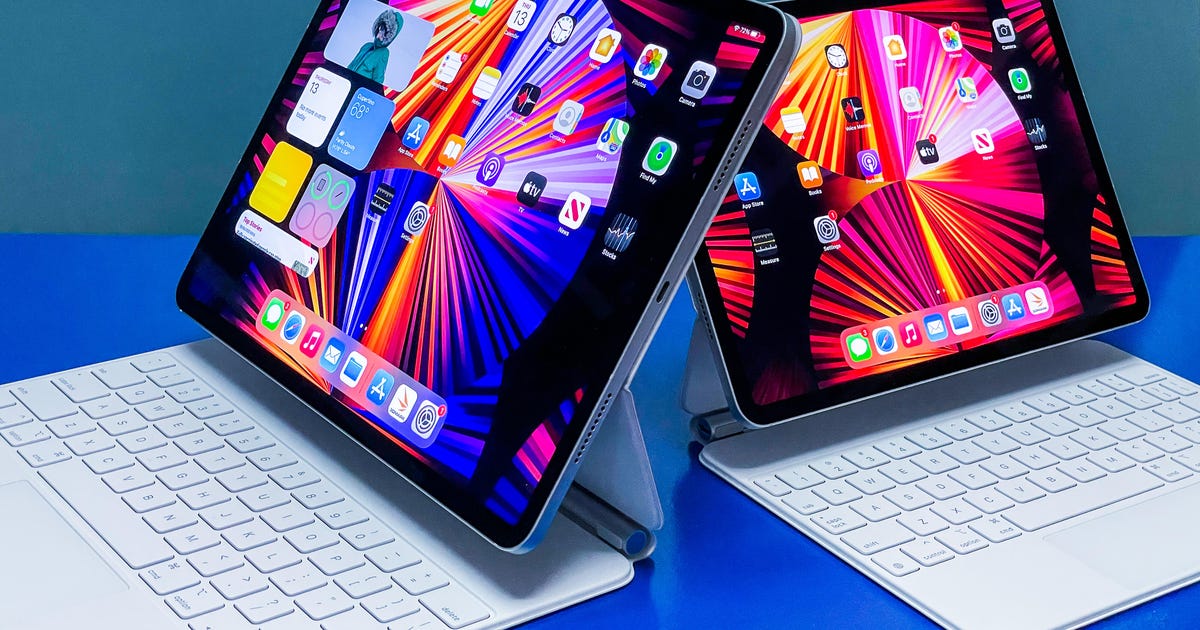
The next MacBook Pros need these features from the iPad Pro
Apple just revamped the MacBook Pros at its latest October event, adding a ton of features, restoring some classic ports, bringing back MagSafe and removing the Touch Bar for good. Look closely and you can see some iPad Pro features making the jump to the Mac this time: mainly, the display. The Mini LED, ProMotion-enabled 120Hz Liquid Retina XDR display on the latest MacBook Pros looks essentially similar to what the M1 iPad Pros have.
But there are also some things iPad Pro still has that I'm surprised haven't also come over. One's a reach, but two are pretty obvious.
Face ID and Center Stage camera
The MacBook Pro's notched display has a new 1080p camera, but it doesn't have the whole TrueDepth camera package of the most recent iPads. That's a shame, on several levels.
Center Stage , a wide angle camera technology that digitally zooms in to follow your face during FaceTime or Zoom (or any other compatible app), is extremely helpful... especially at further-off distances. A laptop seems like a pretty good application.
Face ID, while I don't love it on the iPhone, is pretty useful on the iPad. I find it gets me logged in and into sites a lot faster than Touch ID, but I also wouldn't ever trade it for Touch ID on a laptop. I'd prefer it as another option (also, the TrueDepth camera has Portrait Mode video, which looks pretty nice so far on calls).

Center Stage turns on and off and even zooms in (I'm pointing to the setting on Zoom).
Scott Stein/CNET5G
Apple's laptops still, to this date, don't have cellular connectivity. In 2021, that's pretty weird. I don't think I'd ever need cellular on my own laptop, but I'm not sure why a MacBook can't get 5G. The iPhone has 5G and so does the iPad Pro (the iPad Mini has it too, although not mmWave flavor). All the other iPads have LTE options. Adding 5G at some point would make a lot of sense, if only for business reasons.

MacBooks only come with one keyboard, unlike iPads.
AppleA detachable keyboard and a convertible design
The iPad may never become a Mac. And the Mac may never become an iPad. Fine. I get it. But I still love how the iPad Pro can be snapped in and out of an excellent keyboard and flexed into either a drawing-based tablet mode or a laptop mode on the fly.
There's another reason why that concept appeals to me: It means the keyboard is replaceable. If keys wear out or break down, a new keyboard accessory could be picked up. It's just strange to me that keys, these things we pound on all the time, are bonded to our laptops and can't easily be swapped for other options as needed. I can change up my iPad Pro keyboard to other designs and manufacturers easily. It's nice to do.
And as far as making a touchscreen, Pencil-compatible Mac... we're overdue for that, too.
Source
Solana Saga Is A Fancy Android Phone For Crypto Traders
Solana saga is a fancy android phone for crypto traders wanted solana saga is a fancy android phone for crypto traders forum solana saga is a fancy android phone for crypto traders to copy solana saga is a fancy android phone for crypto traders near solana saga is a fancy android phone for kids solana saga is a fancy android emulator solana saga is a fancy android tablet solana saga iswara solana is it a good investment solana saga islamic priest solana saga island
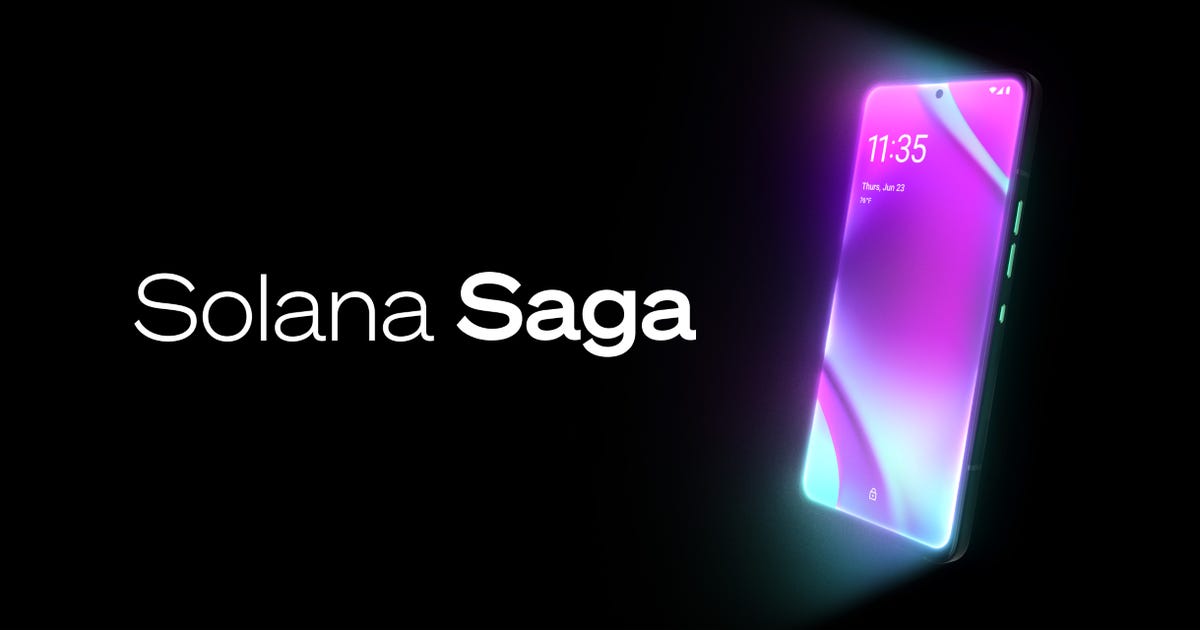
Solana Saga Is a Fancy Android Phone for Crypto Traders
In a first from a major cryptocurrency company, Solana Labs on Thursday announced it was developing its own brand of smartphone. The Solana Saga is a top-spec, 6.67-inch Android phone that'll launch in first quarter of 2023 for $1,000. Revealed at a keynote in New York, the Saga is designed to make trading cryptocurrencies easier and safer on mobile phones.
Solana is a cryptocurrency that competes with ethereum, which is the second biggest cryptocurrency on the market. It aims to dethrone ethereum by being more efficient: It claims to be able to process 50,000 transactions per second, compared with ethereum's 30 per second. It's also cheaper to use and more carbon efficient. Its downside thus far has been security: Solana's network has suffered two complete shutdowns this year alone.
The Solana Saga is a rebrand of OSOM's OV1, which phone afficianados will recognize as the spiritual successor to the Essential Phone. The privacy focused OV1 was slated to hit the market by the end of the year. Other features include 512GB of storage, 12GB of RAM and a Qualcomm Snapdragon+ Gen 1 CPU.
The Saga is a central part of Solana's attempt to make cryptocurrency apps more mobile friendly. Many crypto, decentralized finance and NFT applications are more limited on mobile than on desktop, or have cumbersome user interfaces. Anatoly Yakovenko, CEO of Solana, joked at the event that he still sees people pull out laptops on dates in order to mint new NFTs. "Web3 still feels like we're in the year 2007," Solana mobile head engineer Steven Laver said at the event.
Solana's new Solana Mobile Stack, which will run first on the Solana Saga, is designed to fix that problem. It's open-source software that consists of three main tools: a Mobile Wallet Adapter, a Seed Vault and Solana Pay. The wallet adapter connects Android apps to any Solana crypto wallet stored on the device. The Seed Vault partitions wallet seed phrases and passwords from apps on the phone, attempting to merge the security of a hardware wallet with the usability of an internet-connected wallet. Solana Pay will work similarly to Apple Pay and Google Pay, except the user will be able to transact using the Solana cryptocurrency or Solana-compatible tokens, like the USDC stablecoin.
Source
Crypto's Wild West Days Are Coming To An End
Crypto s wild west days are coming to an end crossword crypto s wild west days are coming to an end but great crypto s wild west days are coming to an end meme crypto s wild west days are coming to an agreement crypto s wild west days are coming to android crypto s wild west days are coming to an or near crypto s wild west days are coming carlebach crypto s wild west days are long years crypto s wild west days are numbered
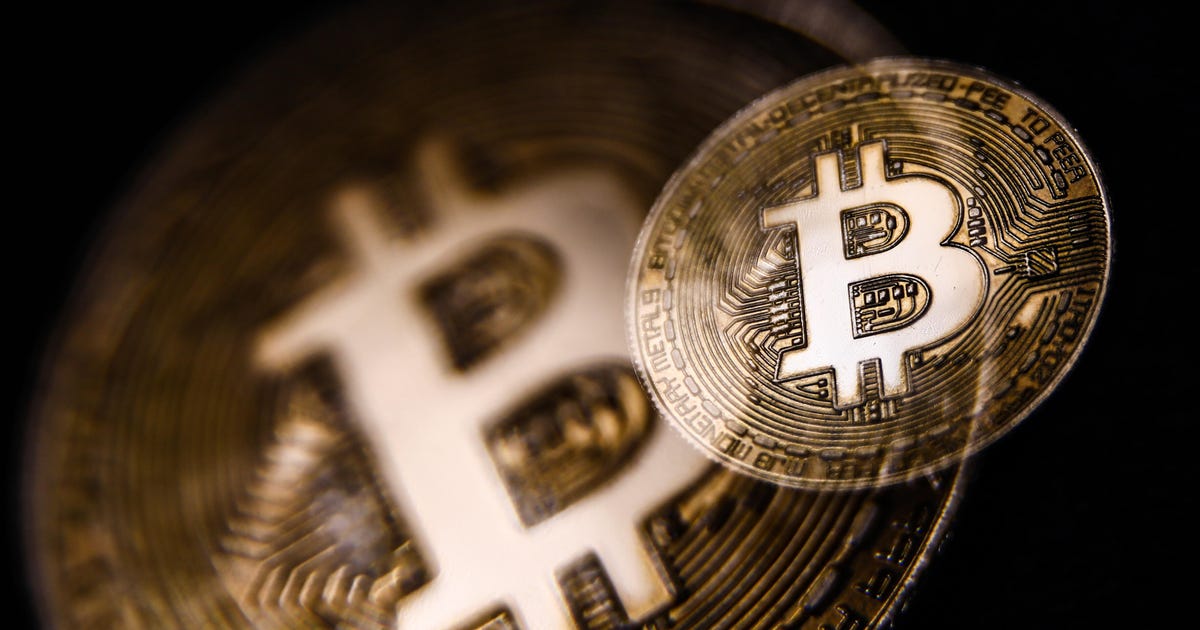
Crypto's Wild West Days Are Coming to an End
Cryptocurrency has been a digital Wild West for over a decade. In the past 13 years, bitcoin alone has minted tens of thousands of millionaires, and a trillion-dollar industry has risen up to serve cryptocurrencies that proponents call the future of finance. At the same time, fortunes have been lost to scams and frauds. As all of this happened, crypto evolved too quickly for regulators to catch up.
That's about to change. Slowly but surely, both regulators and legislators have been homing in on the industry. Though there's polarized uncertainty over how to best do the job, what's clear is that crypto's Wild West days are coming to an end.
To understand how, first consider the US Securities and Exchange Commission. It's seeking to classify most cryptocurrencies as securities rather than digital currencies. Most companies that issue coins would have to meet the same standards as companies that issue stocks, and the SEC would have the power to restrict the activities of crypto firms that don't.
To that end, the SEC has reportedly opened an investigation into Binance, the world's largest cryptocurrency exchange. The commission is looking into whether BNB, Binance's crypto token, should have been classified as a security upon its launch in 2017. The SEC has already been embroiled in a 16-month case against Ripple, making the similar accusation that Ripple's XRP coin should be treated like a security rather than a virtual currency.
Then came the legislative side. On Tuesday, two senators, New York Democrat Kirsten Gillibrand and Wyoming Republican Cynthia Lummis, proposed a sweeping bill that would create a wide-ranging framework in which the entire industry could be regulated. The bill, called the Responsible Financial Innovation Act, is expected to change form over the next year or so, but reflects the bipartisan desire to integrate cryptocurrency into the country's financial and legal systems.
That regulatory impulse has been seen across the country over the six months. New York's Democrat-controlled Senate, in an attempt to address environmental concerns, approved a two-year moratorium on cryptocurrency mining. Republican Sen. Pat Toomey in April proposed a government body to oversee stablecoins – and that was before Terra USD crashed and vaporized $15 billion from the crypto market. The desire goes all the way to the top: In March President Joe Biden released an executive order that called on the Treasury to craft policy that protects Americans from the dangers of crypto investing.
"The necessity to take regulation seriously is what's key here," said David Shafrir, CEO of Secure Digital Markets, a crypto brokerage firm. Shafrir said the industry can't afford "another Mt. Gox," a reference to an infamous 2014 hack of the Mt. Gox exchange that saw $460 million in bitcoin stolen, causing the exchange's bankruptcy and customers to completely lose their investment.
"You can't have these kinds of very clear fraudulent activities occurring, because if you do you completely discredit the industry as a whole."

Senators Cynthia Lummis and Kirstin Gillibrand released a bipartisan bill on Tuesday, proposing a broad framework to regulate crypto. Some have called it too soft on the industry, but it represents a significant starting point in setting rules in a hitherto chaotic space.
Bloomberg/GettyRegulating cryptocurrency is much easier said than done. Bitcoin and ether make up about half of the entire $1.2 trillion crypto market, and both are open source. Neither is operated by a company, and both can operate on a peer-to-peer basis, meaning they don't require an intermediary exchange. The whole point of these technologies is that they're decentralized -- so how do you regulate them when there's no central entity to regulate?
Instead of taking on the technology, regulators have until now sought to confront particular companies that have sprung up around it. Binance and Ripple, both under investigation by the SEC, make easier targets than developers who work on open-source ethereum code. If regulators can target people and companies, Shafrir notes, they serve as a proxy for regulating the technology itself.
"If the brokers, the executives, the employees of all the major industry players all operate under the guise of a regulated industry, then by default a vast majority of everything that's going to happen in the periphery of the industry will behave in a regulated manner," he said.
Yet just because consensus exists over the need to regulate doesn't mean there's consensus over the details. At the moment, there are largely two camps tackling crypto. One believes cryptocurrencies should be treated as securities, and another that thinks they should be classified as commodities.
It sounds dry, but how these crypto tokens are categorized will determine who regulates them. Commodities come under the Commodity Futures Trading Commission, which many argue will give the industry far more leeway and far less scrutiny than the Security Exchange Commission.
Lummis and Gillibrand's bill makes many suggestions, including that goods paid for with crypto under $200 go tax-free, but the most controversial is its proposal to classify most cryptocurrencies as commodities. The positive reaction of many within the crypto industry, as well as the fact that Lummis herself owns six figures' worth of bitcoin, has raised eyebrows.
"When it comes to the goal of both investor protection and financial stability, this bill is a deregulatory departure from the status quo," tweeted Hilary Allen, professor of law at American University's Washington College of Law. "It gives most jurisdiction over crypto assets to the CFTC, which has no investor protection mandate and far fewer resources than the SEC."
Others argue that the SEC would stifle innovation. Patrick Daugherty and Louis Lehot, cryptocurrency experts at the Foley and Lardner law firm, support the bill's proposal to classify cryptocurrencies as commodities.
"The CFTC has a strong record of thoughtful and collaborative regulation over industry, and with other jurisdictions," said Daugherty and Lehot via email. "The SEC, by contrast, has focused on enforcement tools that have served to inhibit the growth of a legal digital asset industry from the start, and is doing everything in its power to block further development with unprecedented regulation."
The SEC declined to comment for this story. The CFTC didn't immediately respond to a request for comment.
A Binance spokesperson told CNET, "We have been working very diligently to educate and assist law enforcement and regulators in the US and internationally, while also adhering to new guidelines. We will continue to meet all requirements set by regulators."
Crypto's explosive Wild West days may be coming to an end. But the spat over who governs the territory may bring some tense moments.
Source
How To Fix A Running Toilet
How to fix a running toilet fill valve how to fix a running toilet flapper how to fix a running faucet how to fix a frozen iphone how to fix error code 403 roblox how to fix an ingrown toenail how to tie a tie

How to fix a running toilet
Sometimes toilets act up. One common problem your trusty throne can develop is that it always runs. This constant flow of water is a noisy nuisance -- and it's also a money-waster that you'll end up paying for on your next utility bill.
Fortunately, it's usually a pretty easy problem to fix. In this guide, I'll lay out the likeliest causes for continually running toilets, and I'll also explain the first steps you should take to troubleshoot and solve the problem. Once you've successfully dealt with it, you'll not only save some cash, but you'll have gained the skills to tackle running toilets whenever and wherever you encounter them.
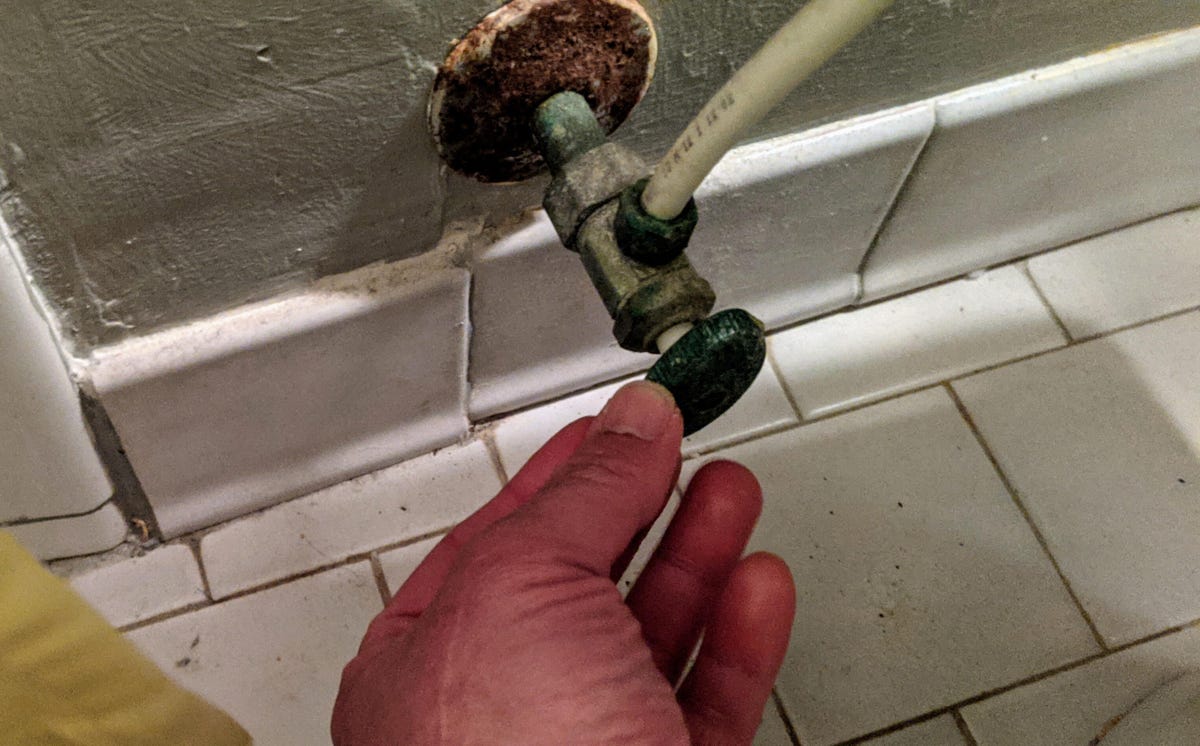
Always turn off the water before working on your toilet.
Brian Bennett/CNETStep 1: Turn off the water
The first step is to turn off your toilet's water supply. Usually it's a small knob on the wall to the right of the toilet that sits close to the floor. Turn the knob all the way to the right (clockwise) to close the valve and pinch off the water supply. Doing the opposite turns the water back on.

Remove the water tank lid to see what's happening inside.
Brian Bennett/CNETStep 2: Remove the tank lid
Carefully remove the ceramic lid from the top of the water tank. It's fragile, so be sure to lower it gently onto a safe resting spot like a bath towel. Now, take a look around. Inside the tank you should see all the main parts responsible for your toilet's water control. These are the flush valve, the fill valve, and the fill tube.
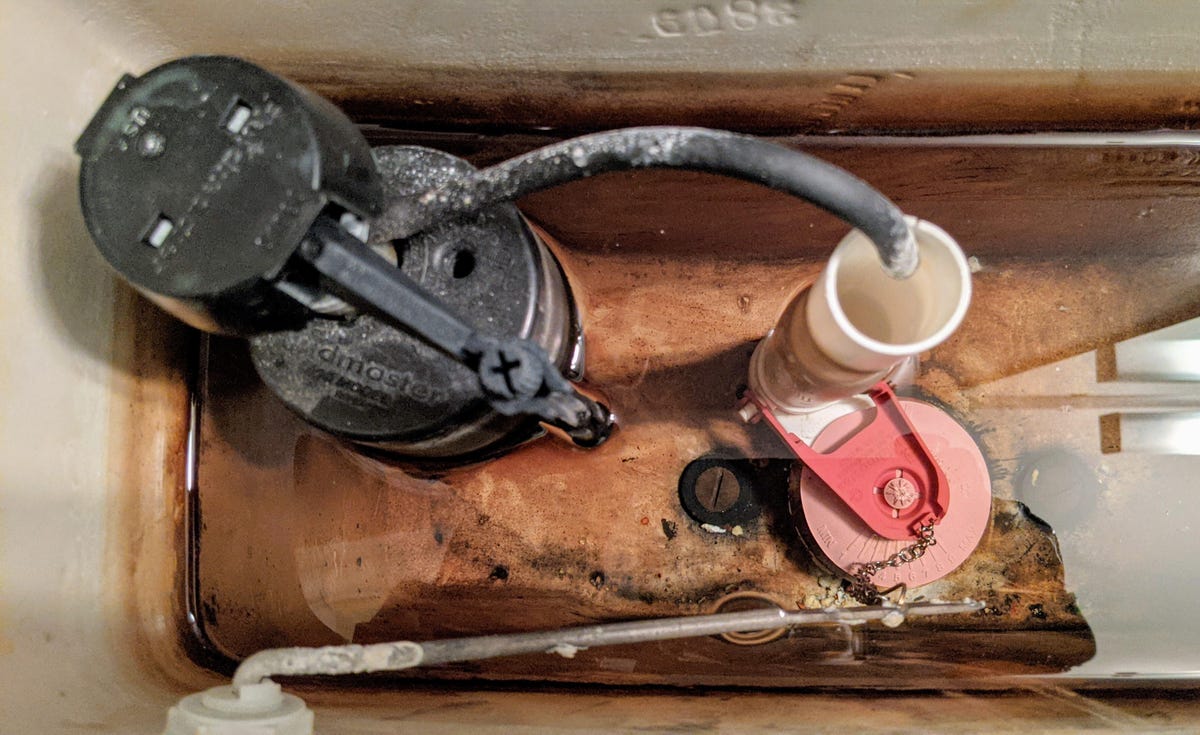
Here's a look at a toilet's water control system. On the left is the fill valve. On the right is the fill tube, flapper, and flush valve.
Brian Bennett/CNETThe fill tube is a hollow plastic cylinder mounted vertically to the floor of the tank. One end of the tube is positioned above the tank's water line. At the other end of the fill tube in the bottom of the tank is the flapper, the rubber or silicone seal around the drain that lifts every time you flush.
The purpose of the fill tube is to accept water from the fill valve to refill the water tank after each toilet flush. It also serves as an overflow pipe to keep water from overflowing the tank.
As the water level in the tank lowers, so too does the float in the fill valve. A lowered float opens the fill valve and lets water refill the tank. Then, as the float rises again, the water stops running once it reaches a preset level.
Step 3: Check the flapper
Sometimes a constantly running toilet is caused by a faulty flapper. If it isn't sealing correctly in between uses, the water will gradually drain from the bottom of the tank, and the toilet will run endlessly in a futile bid to fill it back up.
To check if this is the case, press your finger around the flapper's edges. If the toilet stops running, then your flapper has a bad seal. Next, document how the flapper connects to the bottom of your toilet. Take pictures so you have a record handy, and note the make and model of your toilet, as these details will help you to track down a matching replacement part.
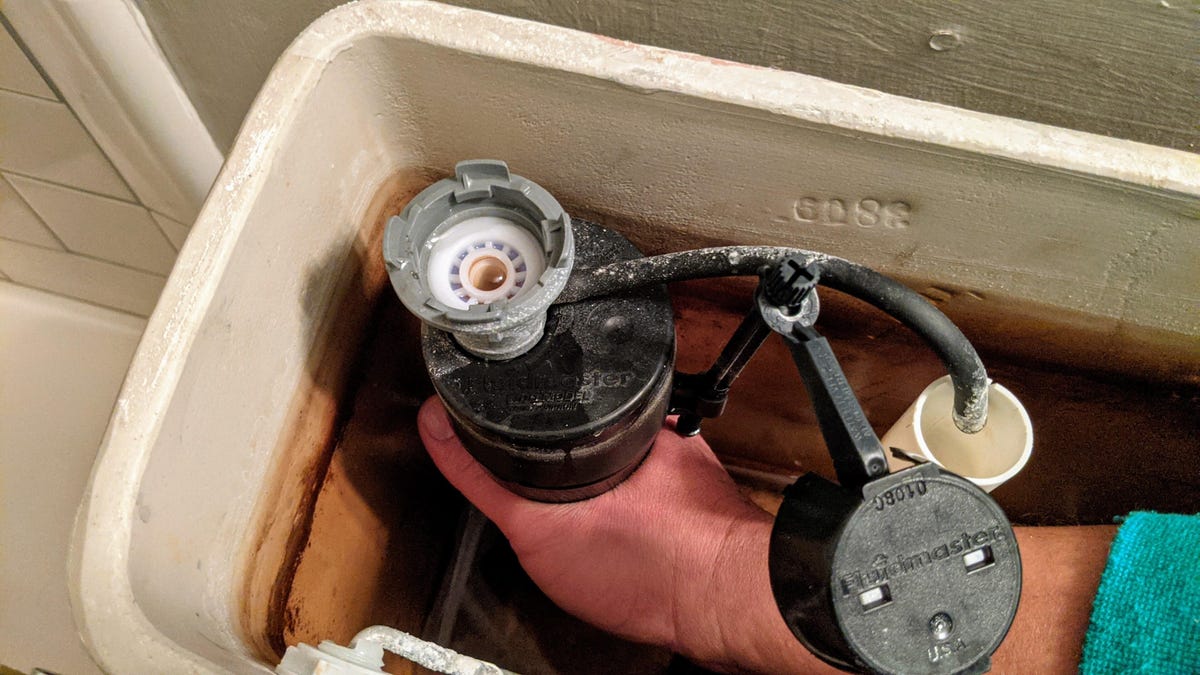
Take the cap off of the toilet fill valve.
Brian Bennett/CNETStep 4: Examine the fill valve
Fill valves can fail over time too. Dirt, debris, or mineral scale deposits can cause the valve to open randomly, making the toilet run intermittently. One quick fix for this problem is to purge the valve. My toilet's fill valve is a Fluidmaster cup-style model. To flush it first reach into the tank with your right hand.
Next lift the float up with it resting on top of your hand. Now grip the valve cap with your left hand and rest your thumb across the cap arm. The arm juts out sideways from the valve cap. Press down on the cap while twisting it counterclockwise one-eighth of a turn. Pulling up should then release the cap.
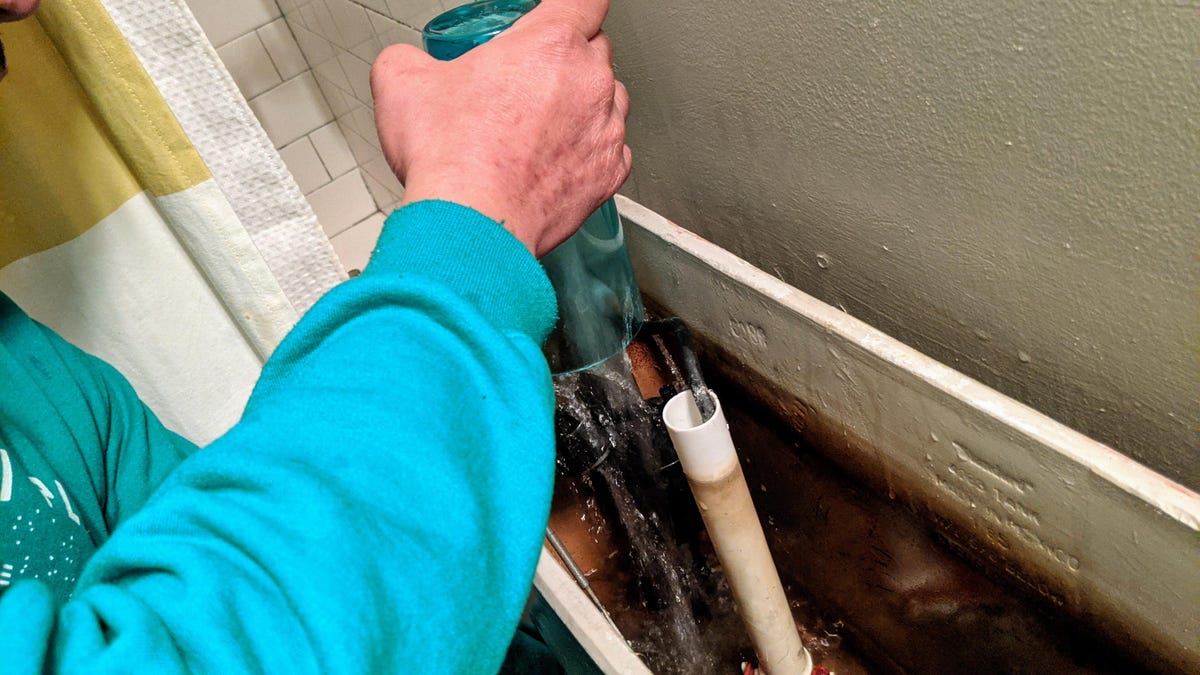
A quick method that might fix your toilet is to flush the fill valve.
Brian Bennett/CNETPlace a cup upside down on top of the valve. Turn the water supply back on to full force. Water will then flow through the valve, clearing any debris. Do this for 10 to 15 seconds, then shut off the water. Reverse the earlier steps to reattach the valve cap. This may solve your running toilet issue. It did in my case.
Another fill valve problem is if the float is set too high. That means the water level in the tank sits above the fill tube. This causes water to constantly drain into the fill tube. It can also lead to water spilling onto the bathroom floor if the toilet ever clogs.
Adjust the water level by first removing the valve cap as before. Next, remove the refill hose from its nipple on the valve shaft. Now, turn the valve shaft clockwise to lower the water level. Turning the valve shaft counterclockwise will raise the water level.
Step 5: Swap in a replacement fill valve if necessary
It may be the case that no amount of cleaning or fiddling will fix your toilet. For example, your fill valve may have failed completely. Your only recourse then is to swap it out for a new unit. It's certainly a more involved process than the other steps above. That said, doing so will greatly increase the lifespan of your toilet. And if your toilet is very old, it'll likely make its water consumption a lot more efficient.
Source
Perinatal Depression: What It Is And How To Cope
What is perinatal depression perinatal depression icd 10 edinburgh perinatal depression scale perinatal depression screening perinatal depression in newborn perinatal anxiety and depression australia edinburgh perinatal depression scale perinatal depression icd 10

Perinatal Depression: What It Is and How to Cope
Britney Spears announced she's expecting a baby on Instagram this week and also revealed that she had perinatal depression when she was pregnant previously.
"I have to say it is absolutely horrible," Spears wrote. "Women didn't talk about it back then."
Perinatal depression is a mood disorder that can start during pregnancy or after childbirth, while postpartum depression specifically describes depression someone develops after giving birth. While the direct causes of the disorders vary, the anxiety, sadness, apathy and other emotions many new or soon-to-be parents feel can be difficult to describe to loved ones or bring up at a doctor's appointment.
Despite this, it's a common medical experience during pregnancy or the postpartum period. According to the American College of Obstetricians and Gynecologists, one in seven women will experience perinatal depression.
Julianne Zweifel is a clinical psychologist and adjunct professor at UW Health in Madison, Wisconsin who works with people who have postpartum mood dysregulation, which can vary from postpartum "baby blues" to postpartum depression. In a September interview with CNET, she said the pressure to feel a certain way can lead new parents to feel inadequate when they don't feel what they perceive to be the "right" feelings.
"I like to describe it as [being] analogous to having only seen black-and-white photos all your life, and suddenly [you] see color photos," Zweifel said about new parents' expectations. "Like, 'wow, I didn't even recognize this dimension existed.'"
The hormonal surges and lifestyle changes pregnancy and new parenthood bring can have dramatic effects on someone's mental health. If you're feeling society's expectation of how pregnant people and new parents should feel doesn't reflect your experience, here's what to know about perinatal and postpartum depression.
Depression during pregnancy
During pregnancy, your body goes through huge changes as it accommodates a new body and prepares for the marathon of childbirth (and parenthood). On top of the physical and hormonal changes, pregnancy can put strain on relationships and cause financial stress. But like depression in people who aren't pregnant, it may also have genetic causes.
According to the Cleveland Clinic, you're more at risk of experiencing depression during your pregnancy if:
- You have a history of depression or premenstrual dysphoric disorder (PMDD, or severe PMS that disrupts daily life).
- You became pregnant at a younger age (risk decreases as age increases).
- You live alone or have limited social support.
- You're experiencing marital problems.
- You have mixed feelings about your pregnancy.
The pandemic may also have increased the rate of anxiety or depression during pregnancy.
While depression can strike at any time in life, many people experience anxiety or depression for the first time while they're pregnant. Because depression can affect the health of the pregnant person and growing fetus, it's important to see your doctor or a mental health professional if you're experiencing symptoms of depression for at least two weeks, the ACOG says. Symptoms include, but aren't limited to:
- Depressed mood most of the day, for most days.
- Feeling guilty, hopeless or worthless.
- Loss of interest in work or activities.
- Sleep problems (sleeping too much or having problems going to sleep).
- Big changes in appetite (losing appetite, or eating much more than normal).
- Having trouble concentrating or making decisions.
- Thinking about death or suicide.
Treatment for depression during pregnancy may be similar to treatment for people who aren't pregnant, including talk therapy or medication, according to the ACOG.
Resources and an expert hotline to call for people experiencing depression during pregnancy and the postpartum period can be found at Postpartum Support International. An analysis of anxiety and depression in pregnant people during the pandemic found that increased social support and physical activity reduced the likelihood of developing either disorder during pregnancy.
Postpartum blues vs. postpartum depression
Zweifel said as many as 65% to 70% of people will experience postpartum "baby blues," or mood swings that begin roughly within a week of delivery. "Once you start using numbers like that, that means that's the normal response," she said. But baby blues will resolve on its own, usually getting better in about seven to 10 days. If feelings of classic depression persist without showing signs of getting better after about two weeks, Zweifel said, it's likely postpartum depression.
Symptoms of postpartum depression can be more intense and last longer than baby blues, and can potentially interfere with your ability to care for your baby or handle daily tasks, according to the Mayo Clinic. PPD can manifest differently and may include typical symptoms of depression, such as severe mood swings, feelings of worthlessness and a withdrawal from family and friends, but may also include feelings specific to your role as a parent, including feelings that you're not a good parent or thoughts and fears that you'll harm your child, per the Clinic.
Zweifel wants to clear up the misconceptions about PPD and the idea that it makes people harm their child.
"Somehow, our society has assumed that's a part of the scenario, and I feel like that's part of the problem," she said. There is a big difference, she said, between fearing that you'll "lose control" and hurt your child, or having intrusive thoughts of you dropping them, than of actually harming your child. "The intent is different there," Zweifel said.
Postpartum psychosis is a very rare condition which can result in the afflicted person attempting to harm themselves or their baby. According to the Mayo Clinic, some of the signs of postpartum psychosis include confusion, paranoia, excessive energy and agitation, hallucinations and delusions.
Read more: 13 Suicide and Crisis Intervention Hotlines to Call or Text When You Need Help

Having a baby with colic, frequent and intense crying in a healthy infant, can increase the risk of postpartum depression in new parents, per the Mayo Clinic.
damircudic/GettyPostpartum depression causes
Many factors can contribute to depression after childbirth, including social factors like not having a support system, societal pressure to feel a certain way and the way a person's body reacts to hormonal changes.
Hormones
Estrogen and progesterone levels skyrocket during pregnancy and then very quickly after birth, they start to drop. This huge dip in hormones is what causes many people to experience strong emotions following birth.
Research suggests that there's not different hormone levels or amounts in people who experience PPD compared to people who don't, Zweifel said. But there might be a difference in how their brain responds to changes in estrogen. Zweifel called the varying chemical effect of estrogen as a "prominent working theory," but it helps explain why oftentimes the people who experience severe mood changes in connection with their menstrual cycle may also be more likely to experience PPD or have more mood-related symptoms during menopause.
"That subset is experiencing the same changes and same patterns," Zweifel said. "But the receptor sites in their brain, essentially, sort of respond differently. They're extra sensitive."
Outside factors
Zweifel said a lot of people experiencing symptoms of depression who come into her office feel better almost immediately after she dispels myths about what makes someone an inferior parent -- missing the "golden hour" of contact with a newborn for medical reasons, for example, or choosing to formula feed instead of breastfeed. Another record she has to set straight is the idea that all parents have an immediate bond with their infant, and if they don't, it means there's something wrong with them.
"Bonding with an infant takes time, and our society does a terrible job of being honest with women about this," Zweifel said. She likes to instill the idea of a "fourth trimester," because there's still so much developing happening on the baby's end in the first few weeks of life that makes the parent-child relationship very straining on the parent, often leaving them "starved for validation" because the baby isn't able to acknowledge the parent, or even able to focus their eyes yet.
In addition to unrealistic expectations of what it means to be a parent, Zweifel said other factors like being the only parent who gets up when the baby cries can exacerbate PPD, or having a child with acid reflux or other medical conditions that require extra care.
Other risk factors, per the CDC, include being a parent to multiples (twins, triplets or more), being a teen parent, having a family or personal history of depression, having a preterm or complicated birth, experiencing difficulty getting pregnant and other stressful events surrounding pregnancy.

Noncarrying parents can also develop postpartum depression.
Getty ImagesPPD is also not a limited experience to the person giving birth. Although the other parent won't be experiencing the hormonal changes that can cause symptoms of depression, similar lifestyle changes, added stress, lack of sleep and societal pressure remain. A 2014 study published in the journal Pediatrics found that depression among new dads increased an average of 68% the first year of their child's life.
If your mental health is a concern to you, reach out for help. If you're interested in seeking treatment with medicine, Zweifel recommends finding a psychiatrist or another professional who works specifically with people on postpartum mood dysregulation.
The information contained in this article is for educational and informational purposes only and is not intended as health or medical advice. Always consult a physician or other qualified health provider regarding any questions you may have about a medical condition or health objectives.
Source
Blog Archive
-
▼
2023
(75)
-
▼
February
(25)
- The Next MacBook Pros Need These Features From The...
- Solana Saga Is A Fancy Android Phone For Crypto Tr...
- Crypto's Wild West Days Are Coming To An End
- How To Fix A Running Toilet
- Perinatal Depression: What It Is And How To Cope
- Best Mattresses For Kids In 2022
- GM's 1,000 Hp 632 Cubic-inch Crate Engine Is Its L...
- Facebook Takes On Nextdoor With Neighborhoods Tool
- Here's How A Digital Detox Will Benefit Your Menta...
- Use This Discounted Precision Screwdriver Set To R...
- Vizio MQX-Series TV Serves Up Local Dimming, 120Hz...
- Clean Your Whole House With Up To $192 Off Yeedi R...
- Oppo Find X3 Pro: 5 Reasons I Love This Beautiful ...
- 2020 Kia Telluride: Detroit Auto Show Debut Turns ...
- 8K TV Explained, And Why You Definitely Don't Need...
- Score A Kid-Friendly Kindle For Just $50 With This...
- We Really Need To Stop Using These 8 Health Buzzwords
- 'Black Bird' On Apple TV Plus: Ending Explained An...
- Amazon Files Lawsuit Against Facebook Group Admins...
- Apple Watch Video Calling Is Coming To Wristcam
- Diary Of An Elden Ring Player: Starting The Action
- Get Three Months Of Amazon Music Unlimited And Sho...
- Learn How To Check Your Social Security Statements...
- AMD Previews CPUs For Cheap Laptops, Flagship Gami...
- Stylish DIY Pokedex Cover Helps With Pokemon Go Ba...
-
▼
February
(25)
Total Pageviews
King of Fighter Hentai
Search This Blog
Menu Halaman Statis
About Me
Featured Post
The Next MacBook Pros Need These Features From The IPad Pro
The next macbook pros need these features from the ipad pro case the next macbook pros need these features from the ipad pro cost the next m...

